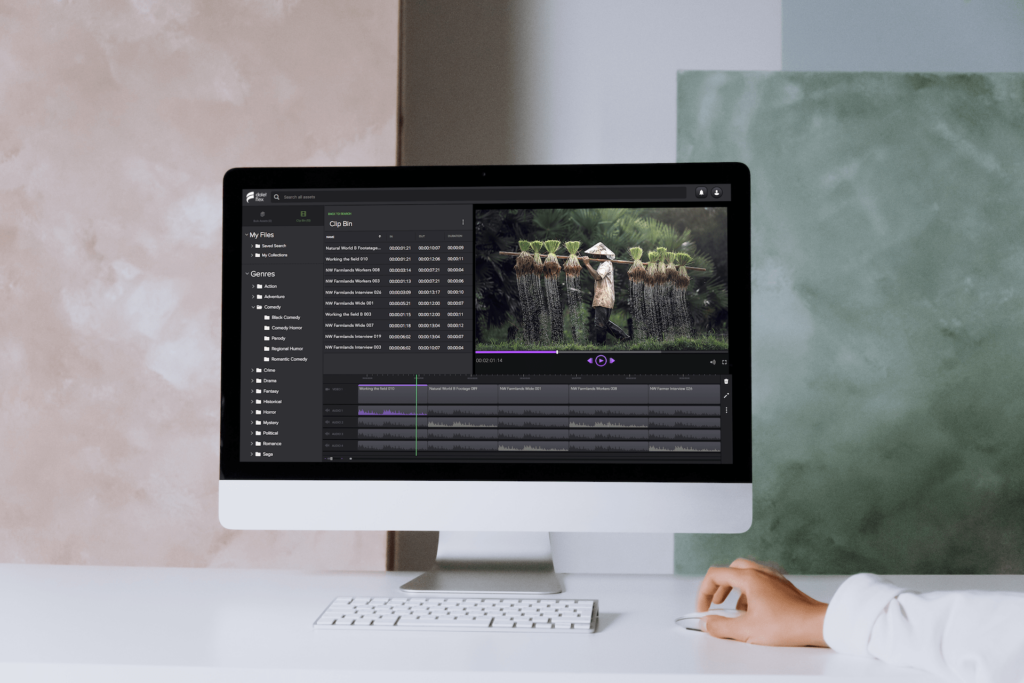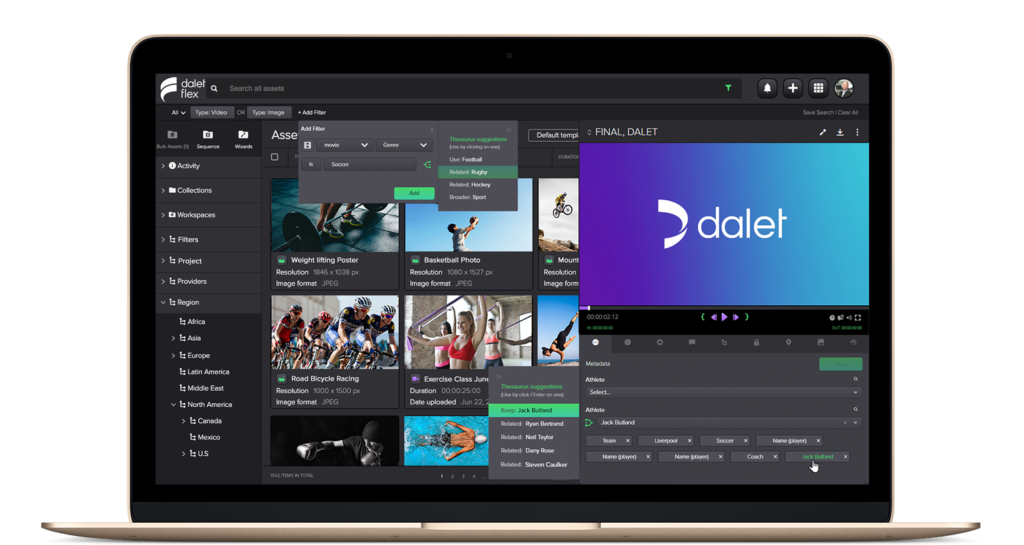Typical ways of working have changed dramatically over the past few years. Remote work and hybrid models have become far more prevalent, for obvious reasons. This has increased the need for home access and remote contributions across the media production and distribution supply chain.
For many organizations, this has accelerated the transition to cloud-based media workflows solutions, which provide ways to address remote access challenges. But they do not come without technical trade-offs and associated business transformations can prove difficult.
The good news is that this switch does not have to be a definite decision between cloud vs on-premises: hybrid media workflows models can offer a more gradual transition path.
The Cloud Question
When considering a migration to cloud solutions, several key benefits are usually at the center of discussions. For Dalet Flex systems, we have found that cloud deployments bring great value to our customers especially regarding:
- Elasticity: Media Workflows can require considerable processing power, especially when working with heavy production formats (e.g. Image Sequences). With auto-scaling capabilities based on Kubernetes, Flex can ensure cloud resources are made available when you need them, without generating extra costs when they are not used.
- Removing network bottlenecks: if a significant part of your workforce is accessing your system from remote locations, assessing cloud vs on-premises hosting solutions is key. Hosting this system on-premises can require high network performances. Host this system in the cloud and part of this network pressure will be redirected accordingly.
- Disaster Recovery: with numerous options available to deploy systems and back-up options in different datacenters and regions, disaster recovery is a key concern that the cloud helps address – and at a lower cost when coupled with auto-scaling functionality.

However, such benefits do not come without their own challenges that can complicate the strategic approach to either cloud or on-premises solutions. When it comes to media workflows, they are often linked to:
- Performance: part of your workforce, especially editors, may require access to heavy high-resolution media files. Accessing those files through an internet connection can prove difficult and impact the user experience.
- Egress costs: cloud providers traditionally charge a fee based on the volume of data read or downloaded from their data center. Solutions must be optimized to reduce those fees that can otherwise add up to significant bills.
- Leveraging existing infrastructure: if you already have an on-premises solution to orchestrate your media workflows, you probably cannot afford to let the underlying infrastructure investment go to waste. If elasticity is a key strength of cloud deployments, relying on your existing infrastructure to provide a resources baseline can be a good approach.
Cloud vs. On-premises Media Workflows: The Hybrid Answer
Hybrid deployments do not require a strict cloud vs on-premises solution decision. With some components on-premises and others in the cloud, can allow you to get the best of both worlds. When it comes to Dalet Flex hybrid solutions, we can distinguish two main categories: multisite deployments and distributed deployments.
The Multisite Model
In a hybrid multisite architecture two Dalet Flex sites are deployed: one on premises, and one in the cloud. Each instance is a full Flex site, able to run independently from the other. We then deploy a Replication Gateway, in charge of replicating content and configuration between those sites. The result is two identical Flex sites, but able to run independently if required.

Several business requirements can lead us to advise a Flex multisite design – amongst them we often encounter:
- Disaster Recovery: one great benefit of such architecture is the ability for each site to run independently, even if its sibling cannot be reached. For instance, if the connection between the cloud and your facilities is interrupted ,users working on your local network will still be able to connect to your on-premises site, while users working from home will still be able to connect to the cloud site – and an automated synchronization will occur when connections are restored.
- Users spread around the globe: we work with a number of broadcasters whose workforce is spread over large geographical areas – sometimes across oceans. In such scenarios, opting for either a cloud or on-premises solution can become problematic. Users far from the physical location of an on-premises Flex site will encounter issues to get a smooth experience (even if only due to physical constraints such as latency). A multisite design can answer this concern.
- Getting started with cloud: a multisite approach can also be a step towards a gradual transition to cloud-based solutions. You can imagine a first step with a cloud Flex system used only for DR purposes or for people working from home, and see this site gradually grow along with new business needs, or as you progressively reduce your Flex on-premises infrastructure.
This is only the tip of the iceberg: the flexibility of our tools governing exchanges and jobs management between sites allows us to further tailor the architecture to your business requirements, even in more complex scenarios:
- Replication policies allow you to define rules narrowing down replication to selected assets and/or configuration items.
- The Jobs Remote Engine service allows you to trigger jobs on your remote cloud site from your local site.
If you are interested in better understanding how a multisite Flex deployment could help you, contact us!
The Distributed Model
You have probably guessed the main downside of multisite deployments: costs. Running multiple full Flex sites will result in a larger technical footprint than a single-site deployment.
Depending on your business requirements, spreading the components of a single Flex site between the cloud and your premises, a distributed architecture can offer an interesting alternative that allows for more flexibility compared to an exclusive cloud or on-premises solution.
The design of a distributed Dalet Flex architecture begins with the deployment of a Dalet Flex instance either on-premises or in the cloud. When it comes to supporting cloud infrastructure providers, Dalet Flex works on Amazon Web Services, Google Cloud Platform, Microsoft Azure and Alibaba Cloud, making it one of the most open and integrated media workflows solutions in the market. Once the initial deployment is in place, we will leverage Flex’s microservices architecture to implement some specific services in additional locations.
Let me give you a use case to make this clearer…
The On-premises Satellite
So, you’ve decided to migrate your content supply chain to a cloud infrastructure. This could be a business-driven decision, to reduce upfront investments and transition to OpEx and subscriptions costs, or a technical decision to accommodate for the increasing number of users working remotely, be it from home or other locations.
This, however, often brings new challenges, especially for production workflows where you may be ingesting large high-resolution files on premises, pre-existing tools deployed in your local infrastructure (QC, transcoding, editing…). Storing such files in the cloud may not be your best option: in addition to performance issues, egress costs (billed by most cloud providers when content stored in the cloud is read by external systems) can be prohibitive.
So you really need to get the best of both! Do consider the following architecture:
- The Dalet Flex Core is in the cloud. This includes databases, storage for proxy files and all the applications that power both the front-end and APIs.
- Your production storage will remain on premises, together with limited computing power running the specific Dalet Flex micro-services that manage high-resolution files and create proxy versions sent to the cloud, so that users can search and preview content in FlexMAM.
The microservices deployed on premises will be fully integrated into the cloud-hosted Flex Core, and can be driven with Flex’s workflow engine just as if they were cloud-hosted too! This hybrid deployment is typically implemented to manage the on-premises content lifecycle, together with smart archiving processes.

Alternatively, you may want to leverage cloud-based artificial intelligence services, like Dalet Media Cortex on the cloud-based proxy files, and trigger specific actions (e.g. archive, task allocation, transcoding….) on the corresponding on-premises high-res content.
All in all, the fact that microservices are spread across different cloud and on-premises locations is transparent for both Dalet Flex and your end users.
What’s the Catch?
When considering a distributed deployment, you should keep in mind that solid and secure cloud connectivity for the on-premises services to connect to the cloud instance is a must.
In addition, whereas in a multisite deployment on premises and cloud services can run independently, this is not the case in a distributed deployment. If a network outage interrupts the connectivity between the on-premises site and the cloud, local users will not be able to access FlexMAM and on-premises services will not be driven by the workflow engine as expected.
To mitigate such risks, we can work with you on Disaster Recovery workflows to keep you working during a possible outage. Of course, such DR transition would be smoother in a multisite architecture which brings additional redundancy, but at a higher cost.
Another point to consider is the need to access high-resolution content from remote locations, for example when video editors need to work from home. An option is edit on the proxy, and render on the local on-premises site… but if editing on the high-res content is required, this will increase the load on the internet connection that serves your premises.
And so… to Cloud or not to Cloud?
If you are pondering over the technical design of your current, or next, media workflows solution, the choice between on premises or cloud is not mutually exclusive. Hybrid solutions provide a gradual transition path to the cloud, be tailored to your business and technical requirements, and optimize your costs. All options come with benefits and trade-offs, which we have briefly summarized in this blog post.
If you’re ready to dive deeper, the Dalet engineering team can help you explore best practices and recommend an approach that meets your business priorities and technical constraints. To find out more about how Dalet Flex can transform your media workflows, get in touch.
Get expert guidance
Featured in: Cloud | cloud media workflows | Cloud vs On-Premises | Dalet Flex | hybrid media workflows | Media Supply Chain | Media Workflows |
Over the past decade, Mathieu has built first-hand experience delivering broadcast projects across Europe and Asia, going on to leading Dalet's EMEA/APAC's Professional Services team. In his current role as VP, Product Management, Mathieu is responsible for shaping Dalet's new generation of solutions.
More Articles By Mathieu



